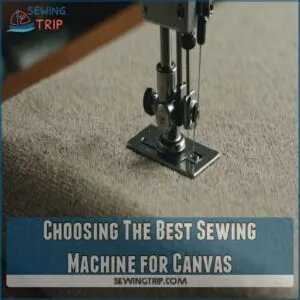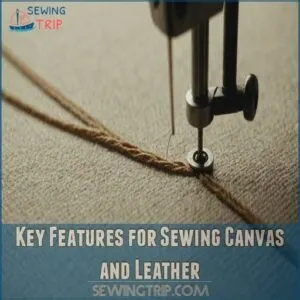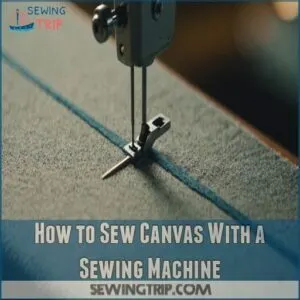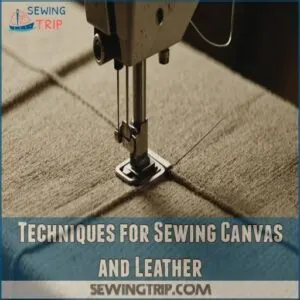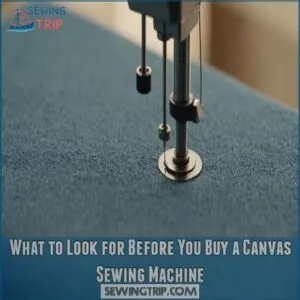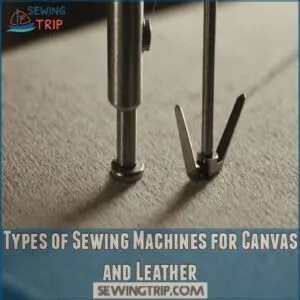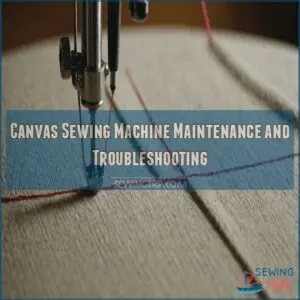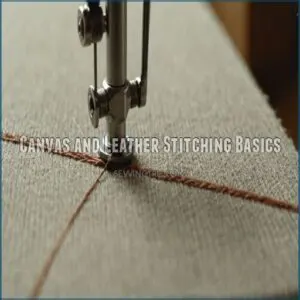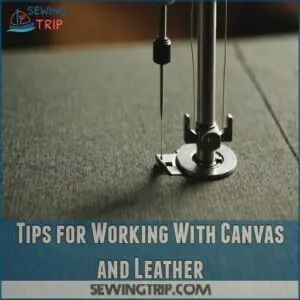This site is supported by our readers. We may earn a commission, at no cost to you, if you purchase through links.

Opt for a heavy-duty model with a robust motor and adjustable settings.
Key features include a walking foot for even fabric feeding, high presser foot lift, and the ability to use heavy-duty needles.
The Singer Heavy Duty 4423 and Janome HD3000 are top contenders, offering industrial-strength performance in a home-friendly package.
Remember, a good canvas machine isn’t just about brute force – it’s about precision and control.
With the right machine, you’ll be stitching through canvas like a hot knife through butter. Stick around to discover which machines made our expert-approved list.
Table Of Contents
- Key Takeaways
- Choosing The Best Sewing Machine for Canvas
- Key Features for Sewing Canvas and Leather
- Top 8 Best Canvas Sewing Machines
- 1. Singer Heavy Duty 4423 Sewing Machine
- 2. Juki HZL F600 Sewing Quilting Machine
- 3. Brother Project Runway Computerized Sewing Machine
- 4. Singer Heavy Duty Sewing Machine
- 5. Brother ST371HD Sewing Machine
- 6. Janome HD3000 Heavy Duty Sewing Machine
- 7. Janome HD1000 Heavy Duty Sewing Machine
- 8. REX Portable Walking Foot Sewing Machine
- How to Sew Canvas With a Sewing Machine
- Techniques for Sewing Canvas and Leather
- What to Look for Before You Buy a Canvas Sewing Machine
- Types of Sewing Machines for Canvas and Leather
- Canvas Sewing Machine Maintenance and Troubleshooting
- Canvas and Leather Stitching Basics
- Tips for Working With Canvas and Leather
- Frequently Asked Questions (FAQs)
- Conclusion
Key Takeaways
Here are 4 key takeaways about the best canvas sewing machines:
- You’ll want a machine with a powerful motor, sturdy metal frame, and adjustable presser foot pressure to handle thick canvas fabrics effectively.
- Top picks like the Singer Heavy Duty 4423 and Janome HD3000 offer industrial-strength performance for home use, with features like walking feet and high presser foot lifts.
- Adjust your machine’s settings for canvas by using a longer stitch length (3.0-3.5mm), higher tension (6-8), and heavy-duty needles (size 100/16 to 110/18).
- Regular maintenance is crucial – clean lint buildup frequently, adjust tension settings as needed, and replace needles every 8-10 hours of canvas sewing for optimal performance.
Choosing The Best Sewing Machine for Canvas
You’ll need a robust machine to tackle canvas, so look for one with a sturdy frame and powerful motor.
Don’t forget to check for an adjustable presser foot, high presser foot lift, and a walking foot to guarantee smooth sewing through thick layers.
Look for Sturdy Frame and Powerful Motor
When you’re on the hunt for a canvas sewing machine, don’t skimp on the basics.
You’ll want to zero in on a sturdy frame and powerful motor.
These workhorses need to handle the heavy lifting of thick fabrics.
Check out canvas sewing machine reviews online for comparisons and expert opinions on the best machines for your needs canvas sewing machine reviews.
Look for machines with metal frames – they’ll stand up to the pressure without breaking a sweat.
A beefy motor (at least 1 amp) is your ticket to smooth sailing through multiple layers of canvas.
Adjustable Presser Foot and High Presser Foot Lift
For thick fabrics like canvas, you’ll need a sewing machine with an adjustable presser foot and high presser foot lift.
These features let you tailor the pressure to your fabric’s thickness, ensuring smooth stitching without puckering or slipping.
A high lift gives you more clearance for bulky projects, making it easier to maneuver multiple layers.
Think of it as giving your machine the ability to "stretch its legs" to accommodate your canvas creations.
Walking Foot for Even Fabric Feeding
A walking foot is your secret weapon for tackling canvas.
This nifty attachment moves both the top and bottom layers of fabric together, preventing slipping and bunching.
You’ll get even stitches and smooth seams, even on thick materials.
Some machines come with built-in walking feet, while others offer them as attachments.
Either way, it’s a game-changer for your canvas projects.
Key Features for Sewing Canvas and Leather
You’ll need some heavy-duty features to tackle canvas and leather like a pro.
From sturdy needles and thicker thread to longer stitch lengths, these key elements will help you conquer those tough fabrics without breaking a sweat.
Heavy-Duty Needles and Thread
Heavy-duty needles and thread are the backbone of canvas sewing. You’ll need some serious firepower to tackle those thick layers:
- Needle size: Go big with 100/16 to 110/18
- Thread type: Opt for polyester or cotton-wrapped polyester
- Needle strength: Look for titanium-coated or chrome-plated options
- Thread thickness: Size 40 is your sweet spot
Remember, matching your needle and thread to your canvas is like finding the perfect dance partner – it’ll make your sewing smooth and effortless.
Longer Stitch Length for Canvas Projects
Longer stitch length is your secret weapon for canvas projects.
You’ll want to bump up your machine’s settings to 3-4mm, or even more for thicker fabrics.
This adjustment prevents puckering and helps the fabric feed smoothly.
Plus, it reduces strain on your needle and thread.
Remember, different canvas weights might need tweaking, so don’t be afraid to test a few stitches before diving into your project.
Interfacing for Stiffer Finish
While longer stitches help with canvas, interfacing can take your projects to the next level.
It adds structure and stability, perfect for bags, jackets, or home decor.
Choose from fusible or sew-in options, depending on your project’s needs.
Light interfacing works for most canvas items, but medium to heavy weights offer extra stiffness for structured pieces.
Remember, interfacing isn’t just for clothes – it’s your secret weapon for professional-looking canvas creations!
Top 8 Best Canvas Sewing Machines
You’re about to discover the top 8 canvas sewing machines that’ll make your heavy-duty projects a breeze.
From the sturdy Singer Heavy Duty 4423 to the versatile REX Portable Walking Foot, these machines are built to handle thick fabrics with ease, so you can tackle everything from upholstery to outdoor gear without breaking a sweat.
1. Singer Heavy Duty 4423 Sewing Machine
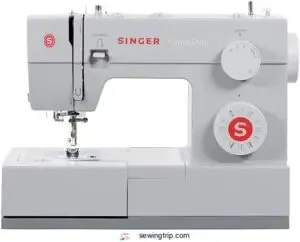
The Singer Heavy Duty 4423 is a workhorse that’ll tackle your canvas projects with ease.
You’ll love its powerful motor, 60% stronger than standard machines, perfect for powering through thick fabrics.
With a sturdy metal frame and stainless steel bedplate, it’s built to last.
The automatic needle threader and top drop-in bobbin make setup a breeze, while the 97 stitch applications offer versatility for various projects.
At 1,100 stitches per minute, you’ll finish your canvas creations in no time.
Just remember to practice with the tension settings to get the perfect stitch.
Best For: The Singer Heavy Duty 4423 is best for sewers who need a powerful machine for heavy-duty fabrics like canvas, denim, and leather.
- Powerful motor for tackling thick fabrics.
- Durable metal frame and stainless steel bedplate for long-lasting performance.
- Variety of stitches and convenient features like automatic needle threading and LED lighting.
- Some users have reported initial issues with thread tension, bobbin jams, and foot control.
- Requires practice to master tension settings for optimal stitches.
- May not be suitable for delicate fabrics or intricate sewing projects.
2. Juki HZL F600 Sewing Quilting Machine
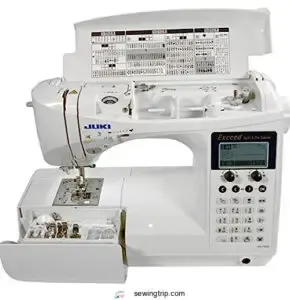
A powerhouse for canvas and quilting, the Juki HZL F600 offers versatility and precision.
You’ll appreciate its 255 built-in stitches, user-friendly LCD screen, and automatic needle threader.
Perfect for both beginners and pros, this machine handles everything from light jerseys to thick fabrics with ease.
The exact 1/4" needle placement is a game-changer for quilters, while the two LED lights provide clear visibility.
With its quiet operation and extensive accessory kit, you’ll be tackling canvas projects like a pro in no time.
Best For: The Juki HZL F600 is best for both beginners and experienced sewers who need a versatile machine for quilting, garment sewing, and handling a wide range of fabrics.
- 255 built-in stitches, including basic, stretch, decorative, letters, and buttonholes.
- User-friendly LCD screen and automatic needle threader make sewing a breeze.
- Quiet operation and extensive accessory kit make it perfect for tackling any project.
- Minor issues with bobbin winding for left-handed users.
- Occasional problems with the needle threader.
- Instruction manual can be difficult to follow.
3. Brother Project Runway Computerized Sewing Machine
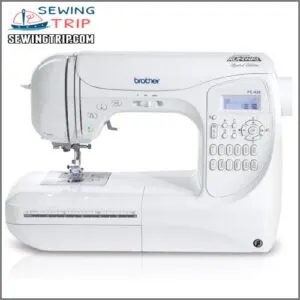
A powerhouse of precision, the Brother Project Runway PC420PRW is your ticket to couture-level stitching.
With 294 built-in stitches and a blazing speed of 850 stitches per minute, you’ll breeze through canvas projects.
The dual LED lighting system illuminates your workspace, while the F.A.S.T. bobbin system keeps you sewing without a hitch.
You’ll love the My Custom Stitch feature for unique designs.
Just keep in mind that the automatic threader can be delicate, so handle it with care.
For canvas work, this machine’s adjustable presser foot pressure is a game-changer.
Best For: The Brother Project Runway PC420PRW is best for experienced sewers who want a machine with advanced features and a wide range of stitches.
- 294 built-in stitches, including decorative and lettering stitches
- Dual LED workspace lighting system and F.A.S.T. bobbin system for smooth sewing
- My Custom Stitch feature for creating unique designs
- Automatic threader can be delicate and may break if not used properly
- Machine does not come with a 1/4 inch quilting foot
- Some users have reported issues with the bobbin case alignment
4. Singer Heavy Duty Sewing Machine
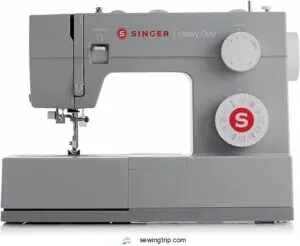
A workhorse in the sewing world, the Singer Heavy Duty Sewing Machine lives up to its name.
With a sturdy metal frame and powerful motor, it handles canvas like a pro.
You’ll breeze through projects at speeds up to 1,100 stitches per minute.
The top drop-in bobbin with clear cover lets you keep an eye on your thread supply.
Plus, with 110 stitch applications and a one-step buttonhole feature, you’re ready for any canvas challenge.
Whether you’re a beginner or seasoned pro, this machine’s durability and versatility make it a solid choice for canvas work.
Best For: This machine is best for those who need a reliable and durable machine for heavy-duty projects, especially working with canvas.
- Handles canvas and other thick fabrics with ease.
- Durable metal frame ensures long-lasting use.
- Offers a variety of stitches and features for diverse projects.
- Some users reported issues with the bobbin cover.
- No printed guidebook included.
- Can be challenging to thread the needle.
5. Brother ST371HD Sewing Machine

Brother’s ST371HD sewing machine packs a punch for canvas projects.
You’ll appreciate its sturdy build and powerful motor, designed to handle thick fabrics with ease.
The automatic needle threader saves time, while the drop-in top bobbin keeps things running smoothly.
With 37 built-in stitches, including an auto-size buttonhole, you’ve got plenty of options for your canvas creations.
The versatile free arm lets you tackle various projects, from bags to appliqué work.
Plus, Brother’s support team has your back if you need a hand.
Just remember, it’s for US use only at 120 volts.
Best For: This machine is best for crafters and sewers who need a reliable machine for a variety of projects, especially thicker fabrics like canvas.
- Sturdy and durable construction
- Powerful motor for handling thick fabrics
- Automatic needle threader for easy threading
- Not compatible with European voltage
- The needle threader can be difficult to use
- No automatic thread cutter
6. Janome HD3000 Heavy Duty Sewing Machine
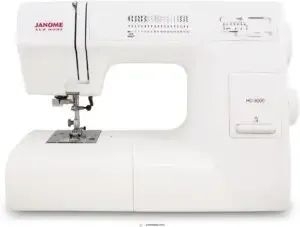
Workhorse meets precision in the Janome HD3000. You’ll love its sturdy aluminum body and powerful motor, perfect for tackling canvas projects.
This machine boasts a one-piece aluminum casting, ensuring stability while you sew.
The top-loading jam-proof bobbin system and 7-piece feed dog make handling thick fabrics a breeze.
With 8 built-in stitches and a one-step buttonhole, you’re set for various canvas creations.
The extra-high presser foot lift and adjustable foot pressure give you full control over your fabric.
Just keep in mind the three-step buttonhole process might take some getting used to.
Best For: The Janome HD3000 is best for sewers who need a durable machine for tackling heavier fabrics like canvas.
- Sturdy aluminum construction for long-lasting use.
- Top-loading jam-proof bobbin system makes handling thick fabrics easy.
- Extra-high presser foot lift and adjustable foot pressure provide control over your fabric.
- The three-step buttonhole process might take some getting used to.
- Not designed for extremely heavy materials like leather or sailboat sails.
- Some users have reported issues with the buttonhole stitch.
7. Janome HD1000 Heavy Duty Sewing Machine
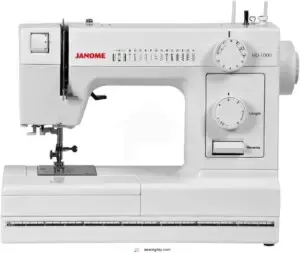
Just like its big brother, the Janome HD1000 packs a punch with its sturdy cast aluminum body.
You’ll love its 14 built-in stitches, including utility, stretch, and buttonhole options.
The automatic needle threader is a game-changer, making threading a breeze.
As a heavy-duty sewing machine, it’s designed to handle tough fabrics with ease, featuring a durable metal frame.
While it might be a bit heavy, this workhorse can handle thick fabrics with ease.
Keep an eye on the front-loading bobbin, as it can be finicky at times.
Despite a few quirks, this machine’s durability and performance on heavy fabrics make it a solid choice for your canvas projects.
Best For: The Janome HD1000 is best for sewers who need a durable machine that can handle heavy fabrics.
- Durable metal construction
- Easy to use, even for beginners
- Automatic needle threader
- Heavy weight
- Bobbin thread can get caught and jam
- Shuttle case may be prone to misalignment
8. REX Portable Walking Foot Sewing Machine
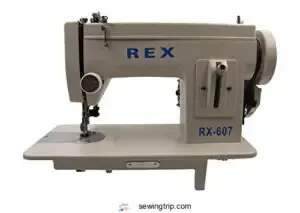
This durable walking foot machine tackles heavy-duty materials like fur, leather, and upholstery with ease.
You’ll appreciate its pre-oiled setup and standard-size bobbins, though you’ll need to adjust the tension settings before first use.
While similar to the pricier Sailrite Ultrafeed LS1, it’s a more budget-friendly option.
The Monster Wheel compatibility gives you extra power and speed control when needed.
Keep in mind you might want to upgrade the foot pedal and consider adding a power switch for better control and safety.
Best For: Experienced sewers tackling heavy-duty materials like leather, fur, and upholstery.
- Durable and reliable for handling thick materials.
- Pre-oiled and ready to use out of the box.
- Compatible with Monster Wheel for added power and speed control.
- Requires tension adjustments and may need foot pedal upgrades.
- Lacks a power switch for safety and control.
- May need presser foot height modifications for thicker materials.
How to Sew Canvas With a Sewing Machine
You’ll need a heavy-duty needle, strong thread, and the right machine settings to tackle canvas projects like a pro.
With your walking foot installed and stitch length adjusted to 3.0-3.5mm, you’re ready to transform that sturdy fabric into anything from durable bags to outdoor gear.
Use Heavy-Duty Needle and Thread
Your canvas projects will shine with the right needle and thread combo.
Pick a heavy-duty needle (size 100/16 to 110/18) designed for thick fabrics – it’s like giving your machine superhero strength.
Pair it with size 40 cotton or polyester thread that can handle the tough stuff.
You’ll want to adjust your tension settings slightly higher than normal to keep those stitches looking pro.
Install Walking Foot for Thick Fabric
Installing a walking foot is especially beneficial when working with thick materials, as it helps to improve the overall quality of your stitches by providing a reliable feed dog system and presser foot, key features to consider when looking for the best sewing machine for thick fabrics, can feel like giving your sewing machine superpowers for handling thick fabrics.
Think of it as having an extra set of feed dogs on top of your fabric, working in perfect sync with the ones below.
The walking foot grips and moves both layers of canvas simultaneously, preventing shifting and bunching that can turn your project into a wrinkled mess.
Adjust Stitch Length for Smoother Feeding
Now that your walking foot is in place, let’s master stitch length adjustment. For canvas and heavy fabrics, increase the stitch length to 3.0-3.5mm. Think of it like taking bigger steps when walking uphill – longer stitches move through thick fabric more smoothly.
- Start with a test piece to find your sweet spot between 3.0-3.5mm
- Keep an eye on thread tension – adjust if stitches pucker
- Slow down your sewing speed with thicker materials
Techniques for Sewing Canvas and Leather
You’ll need to adjust your machine’s settings and master specific techniques to work with thick fabrics like canvas and leather without damaging your needles or thread. To ensure a smooth process, consider using a best heavy duty sewing machine that’s built to handle thick materials.
Whether you’re making a sturdy tote bag or repairing leather boots, these time-tested methods will help you tackle tough materials with confidence.
Adjust Machine Settings for Tension and Stitch Length
When tackling canvas projects, proper machine settings make all the difference.
Start with a higher tension setting (6-8) for balanced stitches that won’t pucker.
For thick canvas, increase your stitch length to 3.0-3.5mm – think of it like taking bigger steps to handle rough terrain.
Test these settings on scrap fabric first, and fine-tune until your stitches look even on both sides.
Sew Slowly to Avoid Breaking Needle or Thread
Speed control makes all the difference when sewing canvas.
Think of it like driving on a winding road – slow and steady wins the race.
You’ll want to maintain even pressure on your foot pedal, keeping your speed consistent but unhurried.
This prevents needle breakage and thread snapping, while giving you better control over those tricky thick spots where multiple layers meet.
Use Sewing Awl for Hand Stitches
Working with tough materials like canvas or leather? A sewing awl‘s your best friend for hand stitches.
This handy tool lets you punch through thick layers while maintaining control.
Think of it as your portable power tool for repairs and tight spots where your machine can’t reach.
Plus, it’s perfect for those decorative touches that’ll make your project stand out from the crowd.
What to Look for Before You Buy a Canvas Sewing Machine
You’ll need to understand key features of canvas sewing machines to avoid costly mistakes and make sure you’re getting the right tool for your projects.
Whether you’re tackling heavy-duty outdoor gear or crafting sturdy bags, your choice of machine will make the difference between smooth sailing and endless frustration.
Appropriate Speed Control for Thick Fabric
A reliable speed control system is your best friend when tackling thick fabrics like canvas.
You’ll want adjustable settings that let you maintain consistent stitching without straining your machine.
For this, consider a machine with an adjustable speed sewing machine feature, which you can find in various models available at adjustable speed options.
Here’s what proper speed control gives you:
- Prevents needle breakage and skipped stitches
- Allows precise control over challenging seams
- Helps maintain even stitch quality, especially around curves and corners
Automatic Needle Threader for Easy Use
An automatic needle threader is a game-changer when you’re working with thick canvas threads.
It not only reduces eye strain and speeds up setup, but also minimizes threading frustration and helps you achieve consistent accuracy, much like the benefits of an easy-to-use sewing machine.
Just like having power steering in your car, this feature makes threading a breeze, especially in low-light conditions or if you’ve got tired eyes.
| Feature | Basic Threader | Premium Threader |
|---|---|---|
| Reliability | Good | Excellent |
| Durability | 1-2 years | 3-5 years |
| Thread Size | Limited | All sizes |
| Maintenance | Monthly | Quarterly |
Types of Sewing Machines for Canvas and Leather
You’ll find three main types of machines suited for canvas and leather work: heavy-duty machines built like tanks, computerized models packed with automated features, and portable walking-foot machines perfect for on-the-go projects.
Whether you’re crafting boat covers or leather accessories, each type offers unique advantages that’ll help you tackle your thick-fabric projects with confidence.
Heavy-Duty Sewing Machines
Three essential features define heavy-duty sewing machines: a robust metal frame, powerful motor, and reinforced components.
You’ll find these workhorses handle thick canvas like butter, with stronger needle bars and enhanced presser foot pressure.
For an extensive selection of heavy-duty sewing machines suitable for canvas, check out best canvas sewing machines.
Most heavy-duty models come with manual controls, making them more reliable for tough fabrics.
Plus, they’re typically more affordable and easier to maintain than their computerized cousins.
Computerized Sewing Machines
Modern computerized sewing machines pack a punch when tackling canvas projects. They’ll streamline your workflow with features like automatic thread cutting, buttonholes, and wireless connectivity options.
- Automatic tension adjustment for consistent stitches
- Built-in stitch patterns perfect for decorative canvas work
- Memory functions to save your favorite canvas settings
- LCD screens for easy navigation and stitch selection
While pricier than mechanical models, their precision and versatility make them worth considering for serious canvas crafters.
Portable Walking Foot Sewing Machines
While computerized machines offer precision, portable walking foot machines let you take your canvas projects anywhere.
You’ll appreciate their compact design and built-in walking foot, perfect for tackling thick materials on the go.
These lightweight champions pack serious power in a travel-friendly size.
Plus, they’re ideal for small spaces or if you’re splitting time between workspaces.
Think of them as your trusty sidekick for mobile sewing adventures.
Canvas Sewing Machine Maintenance and Troubleshooting
You’ll want to use a heavy-duty needle and durable threads designed for sewing canvas. You’ll keep your canvas sewing machine running smoothly by removing lint buildup and adjusting the tension settings regularly.
Tension settings and lint buildup can cause frustrating thread jams and uneven stitches that can turn your canvas project into a headache.
Clean Lint and Debris From Machine
Just like your car needs regular oil changes, which can be compared to the maintenance required for a vintage sewing machine restoration process for heavy-duty machines. Your canvas sewing machine requires frequent cleaning to maintain peak performance.
Make it a habit to brush away lint from the bobbin area and feed dogs after every project.
Use compressed air or a small vacuum to reach tight spots, and keep your machine covered when not in use to prevent dust buildup.
Adjust Machine Tension for Smooth Feeding
After cleaning your machine, proper tension settings can make or break your canvas sewing experience.
Think of tension like a dance between your upper and lower threads – they need to move in perfect harmony.
Checking the thread quality and fiber type, as with thread quality and tension, is also key for achieving the right balance.
- Test your tension on scrap canvas before diving into your project
- Increase upper tension gradually for thicker threads
- Look for balanced stitches with no loops or puckers
- Keep notes of successful settings for specialty threads
For smooth feeding, start with a tension setting of 4-5 and adjust based on your stitch appearance.
Remember, thicker canvas often needs higher tension than regular fabric.
Canvas and Leather Stitching Basics
You’ll master the essential stitching techniques for canvas and leather with three key seam types: overlapping, semi-flat felled, and full flat felled.
Whether you’re crafting a durable canvas bag or working on leather projects, these fundamental stitches will help you create strong, professional-looking seams that’ll stand up to heavy use.
Overlapping Seam for Simple and Efficient Stitch
The overlapping seam gives you a quick win when you’re working with canvas. Let’s break down how it works and why you might choose it for your project.
| Feature | Benefit | Best Use Case |
|---|---|---|
| Simple construction | Fast to execute | Quick repairs |
| Exposed stitching | Easy to modify | Decorative pieces |
| Minimal bulk | Less strain on machine | Lightweight canvas |
You’ll find this seam perfect for beginners – it’s straightforward and gets the job done without any fancy footwork.
Semi-Flat Felled Seam for Clean Finish
Sewing enthusiasts, get ready to up your canvas game with the semi-flat felled seam!
This nifty technique gives your projects a clean finish on one side while boosting water resistance.
Here’s why you’ll love it:
- Sleek appearance on the visible side
- Enhanced durability for heavy-duty projects
- Reduced bulk compared to full flat felled seams
- Easier to execute than its fully flat counterpart
Your canvas sewing machine will thank you for this smooth operator of a stitch!
Full Flat Felled Seam for Durable and Waterproof Stitch
For the ultimate in durability and waterproofing, you can’t beat a full flat felled seam.
This tough-as-nails stitch encases raw edges completely, creating a smooth finish on both sides.
It’s perfect for high-stress areas in canvas projects like backpacks or outdoor gear.
While it takes a bit more time and skill, mastering this technique will elevate your canvas creations to professional quality.
Tips for Working With Canvas and Leather
Before diving into canvas and leather projects, arm yourself with these essential tips to guarantee smooth sailing: When working with leather, consider sewing leather on regular machines to achieve professional results.
- Pre-treat your fabric: Canvas should be washed and dried to prevent shrinkage, while leather needs conditioning to maintain flexibility.
- Choose the right tools: Invest in a heavy-duty sewing machine, sharp scissors, and leather punches for precise work.
- Practice proper technique: Use a longer stitch length and lower tension for thick materials.
Remember, patience is key when working with these sturdy fabrics. Start with smaller projects to hone your skills before tackling that dream leather jacket or canvas sailboat cover.
Keep your machine well-oiled and clean to prevent jams, and always use the appropriate needle size for your material.
With these tips in your toolbox, you’ll be stitching like a pro in no time, creating durable and beautiful pieces that’ll stand the test of time.
Frequently Asked Questions (FAQs)
Which sewing machine is best for canvas?
You’ll want a sturdy machine with a powerful motor for canvas.
For heavy-duty sewing tasks involving thick fabrics like denim and leather, consider heavy-duty sewing machines featuring strong motors and sturdy frames, such as those found in top-rated models discussed in this heavy duty sewing guide. The Singer Heavy Duty 4452 or Janome HD3000 are top picks.
They’ve got the muscle to handle thick fabrics and the features you need for smooth sailing.
Can you use a sewing machine to sew canvas?
Imagine your sewing machine as a trusty steed, ready to tackle the rugged terrain of canvas.
You can definitely use it to sew canvas, but you’ll need the right setup.
Adjust your machine’s settings and use heavy-duty needles for success.
How to choose a canvas sewing machine?
When picking a canvas sewing machine, look for a sturdy build with a powerful motor.
You’ll want adjustable presser foot pressure, a walking foot, and the ability to handle thick needles.
Don’t forget about stitch length options too.
Which sewing machine is best for a marine canvas sewing machine?
Don’t get caught between a rock and a hard place when choosing a marine canvas sewing machine.
You’ll want a heavy-duty model like the Sailrite Ultrafeed LSZ-
It’s built to handle tough fabrics and withstand salty environments.
What sewing machine is best for sewing canvas?
For sewing canvas, you’ll want a sturdy machine with a powerful motor.
The Singer 4423 Heavy Duty is a top pick for those seeking a machine capable of handling thick fabrics with ease, as it features a robust motor similar to other models that offer powerful sewing speed. The Singer 4423 Heavy Duty is a top pick.
It’s got the muscle to handle thick fabrics and won’t break the bank.
Can I sew canvas with a regular sewing machine?
Did you know 80% of sewing machines can handle canvas?
You can use your regular machine, but you’ll need some adjustments.
Switch to a heavy-duty needle, lengthen your stitch, and go slow.
It’s like teaching an old dog new tricks!
Can a Singer heavy duty sewing machine sew canvas?
Yes, you can confidently tackle canvas with a Singer heavy duty machine.
It’s built for tough fabrics, featuring a powerful motor and adjustable settings.
Just remember to use the right needle and thread for smooth sailing through your canvas projects.
What is the best stitch for sewing canvas?
Did you know canvas can handle up to 350 newtons of force per stitch?
For sewing canvas, use a longer stitch length, around 0-5mm, to manage thick fabric and make sure smooth feeding.
Can regular sewing machines handle canvas fabric?
Regular sewing machines can handle canvas, but you’ll need some adjustments.
Use heavy-duty needles, thicker thread, and adjust your tension.
For best results, consider a machine with a walking foot and higher presser foot lift.
How often should I replace needles when sewing canvas?
Change your needle after every 8-10 hours of sewing canvas.
You’ll know it’s time when you hear a "popping" sound or see skipped stitches.
Don’t push your luck; fresh needles keep your projects smooth sailing.
Is prewashing canvas necessary before sewing?
Prewashing canvas isn’t just a suggestion—it’s a game-changer.
You’ll want to give your fabric a good soak before cutting and sewing.
This prevents shrinkage surprises later and makes sure your finished project keeps its shape and fit.
Whats the best thread tension for sewing canvas?
You’ll want to start with a higher tension, around 6-8, for canvas.
Adjust as you go, aiming for balanced stitches.
If the top thread’s too loose, increase tension; if it’s too tight, decrease.
Test on scrap fabric first.
Are there alternatives to sewing machines for canvas?
You’ve got options beyond sewing machines for canvas.
Try hand-sewing with a sturdy needle and waxed thread, or use a speedy stitcher for heavy-duty work.
Fabric glue and grommets offer quick alternatives too.
Conclusion
Exploring the canvas of sewing possibilities, you’re now equipped to choose the best canvas sewing machine for your projects.
Remember, a sturdy frame and powerful motor are your allies in taming thick fabrics.
Whether you opt for the Singer Heavy Duty 4423 or the Janome HD3000, you’re investing in a workhorse that’ll power through canvas like a champ.
With the right machine and techniques, you’ll be stitching up a storm in no time.
Happy sewing, and may your canvas creations be both durable and beautiful!

